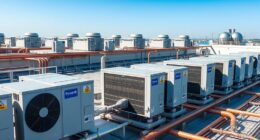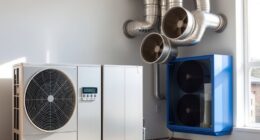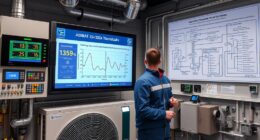A controls architecture for large-scale heat pump HVAC systems combines advanced sensors, scalable controllers, and reliable communication protocols like BACnet or Modbus to guarantee precise regulation. You’ll want to integrate actuators for responsiveness and safety features such as redundancy and fail-safe mechanisms to maintain stability. Optimizing energy use involves demand response strategies and user-friendly interfaces. Exploring these components further helps you build a resilient, efficient system that adapts to your needs seamlessly.
Key Takeaways
- Implement modular, scalable control architectures integrating centralized controllers, local controllers, and communication networks for large-scale heat pump systems.
- Utilize advanced sensors—temperature, pressure, flow—to enable precise, real-time data-driven control and energy optimization.
- Deploy adaptive and predictive algorithms, including model predictive control (MPC), for dynamic load balancing and system responsiveness.
- Ensure robust communication protocols (BACnet, Modbus) with secure, redundant network architecture for reliability and safety.
- Incorporate user-friendly interfaces and remote monitoring tools for efficient management, fault detection, and demand response integration.
Understanding the Core Components of HVAC Controls Systems
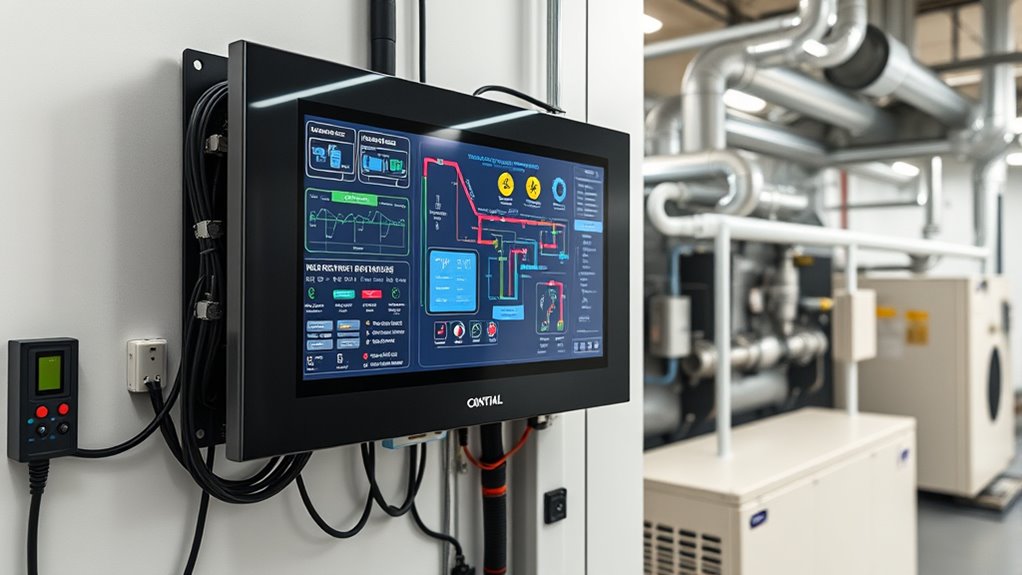
Understanding the core components of HVAC controls systems is essential to optimizing large-scale heat pump operations. Historically, control trends focused on simple thermostats and basic on-off switches, limiting efficiency. Today, emerging control technologies provide sophisticated solutions like centralized controllers, variable frequency drives, and smart algorithms that adapt to real-time conditions. These advancements enable better system responsiveness and energy savings. Modern control systems integrate components such as programmable logic controllers (PLCs), communication networks, and user interfaces, ensuring precise regulation of temperature, humidity, and system performance. Additionally, sensor technology plays a crucial role in providing accurate data for control algorithms, further enhancing system efficiency. By understanding how these core components work together, you can better design or upgrade your heat pump controls, leveraging both historical insights and cutting-edge innovations to optimize efficiency, reliability, and long-term operation.
Key Sensors and Measurement Technologies for Large-Scale Heat Pumps

Effective operation of large-scale heat pumps depends heavily on accurate, real-time data from key sensors and measurement technologies. Sensors such as temperature, pressure, flow, and humidity sensors provide critical data for system control and efficiency. To guarantee measurement accuracy, regular sensor calibration is essential, preventing drift and maintaining reliable readings. High-quality measurement devices use advanced technologies like ultrasonic flow meters, thermocouples, and differential pressure sensors to capture precise data. Accurate sensors enable better decision-making, optimize energy use, and enhance system responsiveness. Investing in robust measurement technologies and maintaining calibration routines helps you achieve consistent performance and system reliability, ultimately supporting efficient large-scale heat pump operation. Additionally, incorporating AI-driven analytics can further refine data interpretation and predictive maintenance, leading to even greater system optimization and longevity.
Integration of Actuators for Precise Control and Responsiveness
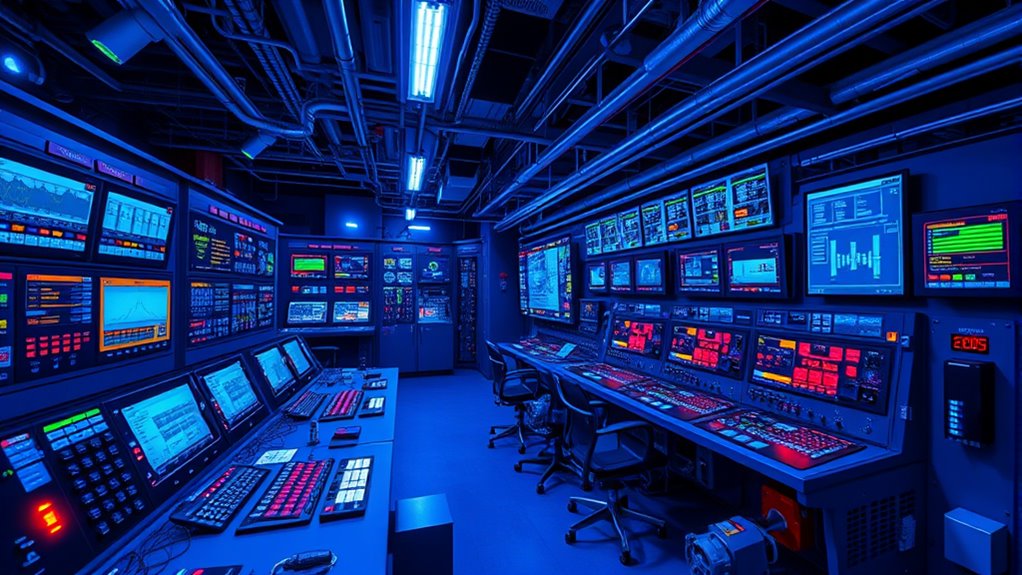
Choosing the right actuators is essential for achieving accurate control in large-scale heat pump systems. Your selection strategies directly impact system responsiveness and stability. By optimizing actuator integration, you can enhance overall performance and guarantee reliable operation. Considering Kia Tuning options can also provide insights into how performance modifications influence system efficiency and control precision.
Actuator Selection Strategies
Selecting the right actuators is essential for achieving precise control and quick responsiveness in large-scale heat pump HVAC systems. To optimize performance, focus on smart actuator selection and adaptive actuator control, which adapt to changing system demands. When choosing actuators, consider these strategies:
- Match actuator type to specific control tasks
- Prioritize high-precision and reliable devices
- Ensure compatibility with control system interfaces
- Incorporate sensors for real-time feedback
- Opt for scalable solutions to accommodate system expansion
- Understand the importance of prophetic dreams in detecting underlying system issues and forecasting future performance trends.
Enhancing System Responsiveness
Integrating actuators seamlessly into a large-scale heat pump HVAC system substantially boosts its responsiveness and control precision. When actuators respond quickly and accurately, you can maintain ideal temperatures and air quality, directly enhancing user comfort. This precise control also supports predictive maintenance by detecting minor deviations early, preventing costly failures and reducing downtime. Enhanced responsiveness allows the system to adapt swiftly to changing conditions, improving overall efficiency. By fine-tuning actuator performance, you ensure smoother operation and quicker adjustments, keeping occupants comfortable and system performance excellent. Proper integration not only elevates comfort but also streamlines maintenance, saving time and resources. Additionally, understanding relationship dynamics can improve communication between system components, leading to even more reliable operation. Ultimately, this approach creates a more reliable, adaptable system that meets both comfort and operational objectives effectively.
Control Algorithms and Strategies for Optimal Performance
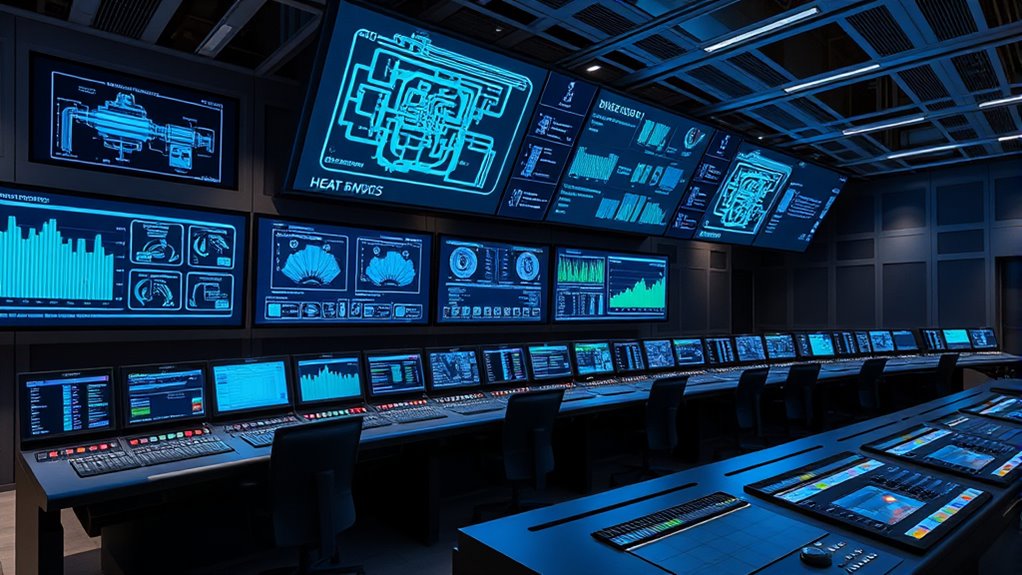
You can improve large-scale heat pump performance by implementing adaptive control techniques that respond to changing conditions in real time. Energy optimization strategies help reduce operational costs while maintaining comfort levels. Exploring these algorithms allows you to maximize efficiency and guarantee reliable system performance. Additionally, integrating AI-driven analytics can further enhance system safety measures by enabling predictive maintenance and early fault detection.
Adaptive Control Techniques
Adaptive control techniques are essential for maximizing the performance of large-scale heat pump HVAC systems, as they allow the system to respond dynamically to changing environmental conditions and load demands. These techniques use adaptive tuning to refine control parameters in real-time, ensuring ideal operation. Predictive adjustments enable the system to anticipate future changes, reducing lag and improving efficiency. By continuously learning from system behavior, adaptive controls maintain comfort and energy savings even during unpredictable conditions. Incorporating self-learning algorithms can further enhance system adaptability by enabling more precise and autonomous adjustments based on historical data and ongoing performance analysis.
Consider these key aspects:
- Real-time parameter updates through adaptive tuning
- Utilizing sensor feedback for accuracy
- Anticipating load changes with predictive adjustments
- Enhancing stability during variable conditions
- Minimizing manual intervention with automatic calibration
Energy Optimization Strategies
To achieve maximum efficiency in large-scale heat pump HVAC systems, implementing advanced control algorithms is essential. These strategies dynamically adjust system operations to optimize energy use while maintaining thermal comfort and indoor air quality. By integrating real-time data, such as occupancy patterns and outdoor conditions, you can fine-tune heating and cooling loads, reducing energy waste. Control algorithms like model predictive control (MPC) or fuzzy logic help balance comfort and efficiency, ensuring indoor environments stay within desired parameters. They also enable proactive responses to system fluctuations, preventing overworking or short-cycling. Additionally, considering energy-efficient components and practices can further enhance overall system performance. Ultimately, energy optimization strategies enhance system performance, lower operating costs, and support sustainable building management without compromising occupant comfort or air quality.
Communication Protocols and Network Architecture

Effective communication protocols and a robust network architecture are essential for the reliable operation of large-scale heat pump HVAC systems. They guarantee seamless data exchange and control coordination across devices. Wireless communication offers flexibility and reduces wiring complexity but requires strong network security measures to prevent cyber threats. When designing your network, consider:
Reliable network architecture ensures seamless data exchange and secure control of large-scale heat pump HVAC systems.
- Using reliable protocols like BACnet or Modbus for interoperability
- Implementing secure wireless communication standards such as WPA3
- Segmenting networks to isolate critical control systems
- Employing encryption to protect sensitive data
- Ensuring redundancy to maintain system stability during failures
- Incorporating security measures for wireless communication to safeguard against potential vulnerabilities
Scalability and Modularity in Controls Design

You need a controls system that can grow with your infrastructure, so modular strategies become essential. By designing for scalability, you make certain of seamless integration of additional heat pumps and zones over time. This approach keeps your system flexible, efficient, and easier to maintain as your needs evolve. Incorporating preservation efforts into your design ensures long-term sustainability and adaptability of your HVAC controls.
Modular Control Strategies
Implementing modular control strategies in large-scale heat pump HVAC systems offers a practical approach to managing complexity and enhancing scalability. These strategies enable you to break down the system into manageable units that can operate independently or collaboratively. This flexibility supports dynamic load balancing, ensuring ideal energy use during fluctuating demands. Additionally, modular controls facilitate environmental adaptation, allowing each module to respond effectively to local conditions. With this approach, you can easily add or modify components without overhauling the entire system. Key benefits include:
- Simplified system expansion
- Improved fault isolation
- Enhanced operational flexibility
- Easier maintenance
- Better responsiveness to environmental changes
Scalable System Integration
Scalable system integration is essential for guaranteeing that large-scale heat pump HVAC systems can grow and adapt efficiently. As your system expands, maintaining thermal comfort and indoor air quality becomes more complex. A modular approach allows you to add or reconfigure components without overhauling the entire control architecture. This flexibility ensures consistent indoor climate and air quality, even as demands change. Proper integration across subsystems streamlines communication and data sharing, enabling real-time adjustments for ideal performance. Scalability also supports energy efficiency and system resilience, reducing operational costs. By designing controls that are both scalable and modular, you guarantee your HVAC system remains adaptable, reliable, and capable of delivering consistent thermal comfort and indoor air quality regardless of size or complexity.
Fail-Safe Mechanisms and Redundancy Considerations
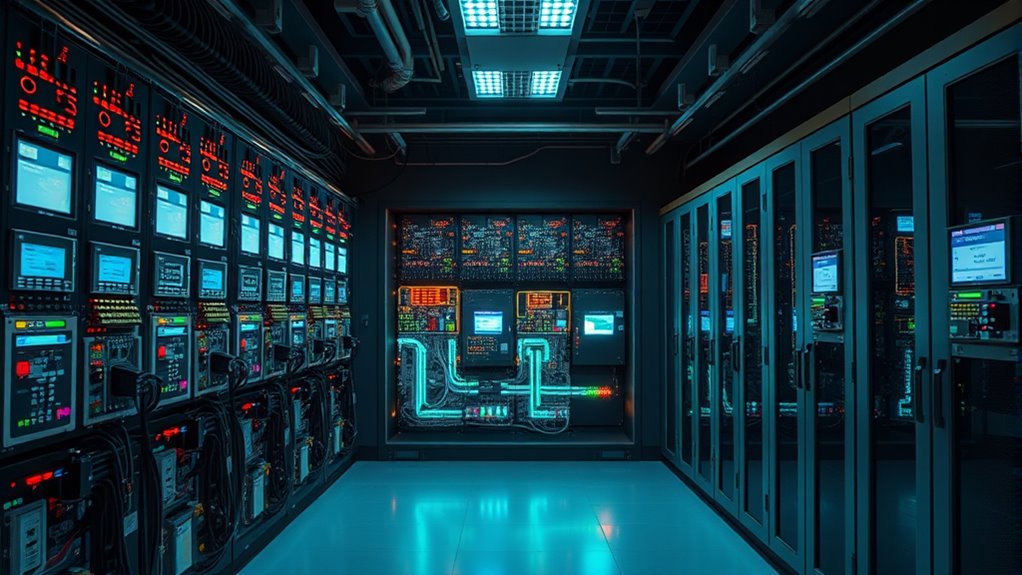
Ensuring reliable operation in large-scale heat pump HVAC systems requires robust fail-safe mechanisms and thoughtful redundancy strategies. Redundant safety features prevent system failures and protect equipment and personnel. A fail-safe design guarantees that, during a malfunction, the system defaults to a safe state. To achieve this, consider:
- Incorporating multiple layers of redundant safety controls
- Using automatic shutoff valves for critical components
- Implementing backup power supplies for essential controls
- Designing failover protocols for communication failures
- Regularly testing safety systems to verify redundancy effectiveness
Data Management and Monitoring for Continuous Optimization

Effective data management and monitoring are indispensable for maintaining peak performance in large-scale heat pump HVAC systems. By collecting real-time data, you can identify patterns and anomalies early. Predictive analytics play a crucial role, enabling you to forecast equipment issues before they occur, reducing downtime and maintenance costs. Data visualization tools help you interpret complex data sets quickly, providing clear insights into system health and performance trends. Continuous monitoring ensures you stay informed about operational efficiency, allowing for timely adjustments. Implementing robust data management practices supports proactive decision-making and system optimization. This approach not only improves reliability but also maximizes energy savings, ensuring your HVAC system operates at its best over the long term.
Energy Efficiency Strategies and Demand Response Integration
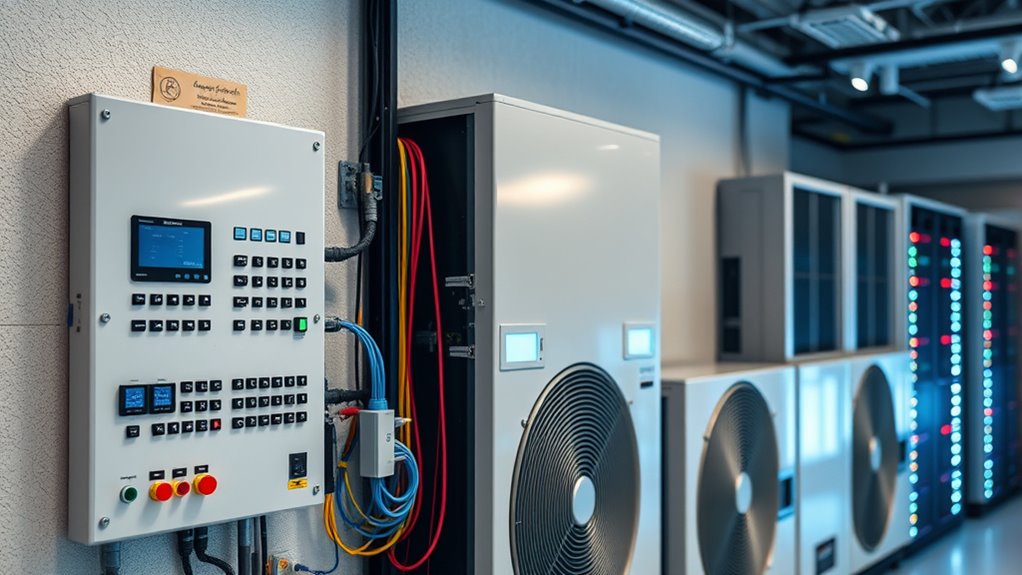
Integrating energy efficiency strategies with demand response capabilities allows you to optimize HVAC system performance while reducing energy costs. By leveraging zoning optimization and thermal zoning, you can tailor heating and cooling to specific areas, minimizing waste. Demand response enables you to shift or reduce energy usage during peak periods, saving costs and easing grid stress. To maximize benefits, consider:
- Adjusting thermal zoning based on occupancy patterns
- Using smart controls for real-time demand response adjustments
- Incorporating predictive analytics for proactive energy management
- Implementing variable speed compressors for load flexibility
- Prioritizing zones with higher thermal inertia for stability
This approach guarantees your large-scale heat pump system operates efficiently, responds swiftly to grid signals, and maintains occupant comfort.
Implementing User Interfaces and Control Interfaces

Implementing user and control interfaces is essential for managing large-scale heat pump HVAC systems efficiently. A well-designed user interface improves user experience by making system controls intuitive and accessible. Focus on user interface design that simplifies complex functions, enabling quick decision-making and reducing errors. To illustrate, consider this example of interface options:
| Interface Type | Key Feature | User Experience Impact |
|---|---|---|
| Touchscreen Panel | Clear visuals, easy navigation | Enhances ease of use |
| Mobile App | Remote access, notifications | Increases flexibility |
| Web Dashboard | Data visualization, control | Improves monitoring |
Choose interfaces that align with user needs, promoting efficient system operation and better control.
Frequently Asked Questions
How Do Controls Architectures Adapt to Different Climate Zones?
You can adapt controls architectures to different climate zones by focusing on climate adaptation and zoning flexibility. By implementing smart controls, you enable your system to adjust heating and cooling based on local temperature variations, humidity, and seasonal changes. Zoning flexibility allows you to target specific areas, optimizing comfort and efficiency across diverse climates. This approach guarantees your HVAC system performs effectively, providing tailored comfort while conserving energy in any climate zone.
What Cybersecurity Measures Protect Large-Scale Heat Pump Control Systems?
You need to implement strong cybersecurity protocols to protect large-scale heat pump control systems. By using firewalls, encryption, and secure authentication, you can prevent unauthorized access. Regular software updates and intrusion detection systems help identify threats early. These measures contribute to effective threat mitigation, ensuring your HVAC system remains safe from cyber attacks, maintains operational integrity, and avoids costly disruptions or data breaches.
How Do Controls Systems Handle Unexpected Equipment Failures?
When unexpected equipment failures happen, your control system uses fault detection to identify issues quickly. It then relies on system redundancy, such as backup components or alternate control paths, to keep operations running smoothly. This guarantees minimal disruption and maintains system efficiency. You can trust that these features work together to detect failures early and switch to backup systems seamlessly, safeguarding your HVAC operations against unexpected equipment problems.
Can Controls Architecture Support Integration With Renewable Energy Sources?
You can design your controls architecture to support renewable integration by incorporating advanced energy management systems that adapt to fluctuating renewable sources like solar or wind. This setup allows real-time adjustments, optimizing heat pump performance while maximizing renewable energy use. By integrating sensors, smart controllers, and communication protocols, your system guarantees efficient energy management, reduces reliance on non-renewable sources, and enhances overall sustainability in your HVAC operations.
What Are the Cost Implications of Advanced Control Strategies?
You’ll find that advanced control strategies can lead to significant cost savings through optimized energy use and reduced operational expenses. However, you should also consider implementation challenges, like higher initial setup costs and system complexity. While these strategies may require more investment upfront, the long-term benefits often outweigh the costs, making your HVAC system more efficient and sustainable over time.
Conclusion
Mastering the controls architecture for large-scale heat pump HVAC systems is like conducting a symphony—you coordinate sensors, actuators, and algorithms to create harmony. With seamless communication and smart fail-safes, you guarantee performance stays in tune. By fine-tuning data management and energy strategies, you turn your system into a well-oiled machine that responds effortlessly to demand. Ultimately, you craft an orchestra of efficiency, where every component plays its part in perfect harmony.





